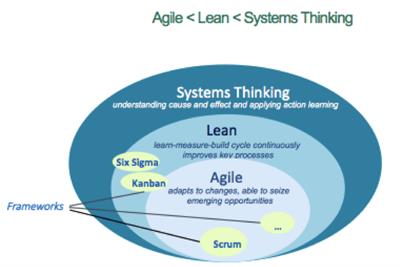For the business leaders who are looking to enhance effectiveness during these difficult times, following a methodology like Six Sigma provides a seemingly easy way to move forward with a roadmap to follow.
[Repost by Julee Everett on TheAgileCorner.com]
I have clients in two diverse domains – material sciences and life sciences – that are currently investing in maturing their business agility using Scrum. Recently, both clients asked about introducing Six Sigma practices into their organizations. They pose the question – can Scrum and Six Sigma co-exist?
The short answer – of course they can, and they should, if the problem requires it. Please read on and share your opinion at the end of this blog.

What is Six Sigma? Motorola developed Six Sigma in 1986. Six Sigma is a structured methodology for process improvement and problem-solving. The tools, techniques and roadmaps aim to reduce variation, improve the quality of production processes by decreasing the number of defects and improve the capability of the processes, products and services. Six Sigma gained popularity quickly in the manufacturing domain, mainly because of its origin and the main objective of reducing variation in production processes.
What is Lean? Lean has deep roots, often associated with Dr. Deming, the Japanese, and in particular the phenomenal continuing success of Toyota. The Lean movement has been rising in parallel to Motorola’s Six Sigma movement and is finding success in many industries beyond manufacturing. Basically, the Lean philosophy systematically eliminates waste. Anything other than creating value can be a target for elimination. Lean and Six Sigma were eventually combined to produce what was called Lean Six Sigma: a systematic approach for process improvement and problem-solving aiming to reduce variation, remove waste and increase capability.problem
What is Agile? Agile is a mindset, often mistakenly used as a synonym for the Scrum framework. Until recently, Agile was seen as a set of practices relevant mostly to software development, because it was created by software developers looking to achieve a smarter way of creating useful software. Agile’s foundational document is the Agile Software Manifesto (2001).
What is Scrum? Scrum is a well-known and widely practiced Agile framework used for delivering products in complex, human-centric environments, such as software development. By the nature of software development, you’ll always find variation due to complexities associated with the interdependencies of individual skills and team dynamics. From this perspective, variation is not perceived as a problem in software development because different engagements are not identical (at best, similar) and thus, not repetitive. That makes Scrum a strong solution for software, but now we are also seeing a steep rise in the use of Scrum outside of IT, in domains like Marketing, Recruiting, and Education.
What is the problem you are trying to solve?
There are many best practices shared among Agile, Scrum, Lean and Six Sigma. They are complementary disciplines, which rely on data, are committed to reducing waste, and intentional in the pursuit of continuous improvement. In order to make the right decision, define the problem first, and then choose the best combination for your needs. If your goal is primarily to remove variation in a repetitive production process, Six Sigma can be a successful approach. If you are working in human-centric and innovation-focused domains like software, Lean UX, creatives and marketing, an agile approach with Scrum is the method you can use to gain higher team performance in your pursuit of continuous improvement.
The big picture: Agile is a subset of Lean, which is a subset of Systems Thinking

Both agile frameworks and lean models focus on achieving business goals and delighting clients with a competitive product of the best quality. But a team can only get so far without hitting obstacles if the rest of the organization is not maturing along the same agile roadmap. We need to encourage Lean thinking in management (continually reduce waste and remove impediments) and Systems Thinking in leadership (all parts of an organization interrelate and affect each other). [Read more about Agile < Lean < Systems Thinking here.]
Adopt a Systems Thinking approach
Six Sigma and Scrum can coexist in organizations when leaders really understand how to apply Systems Thinking at the portfolio level. The modern portfolio management system provides:
- A culture of innovation with clear organizational objectives. Autonomy without alignment is waste.
- Cross–functional teams. Ruthlessly mitigate dependencies.
- Safety to let people be awesome, feel awesome, and act awesome.
- Opportunities to learn. Pause. Listen. Adapt. Celebrate.

Empower people and enable flow
A modern management system is built for agility and innovation. With the right balance of strong alignment and healthy autonomy each team should choose the toolkit that best solves their problems, which can include both Scrum and Six Sigma.





